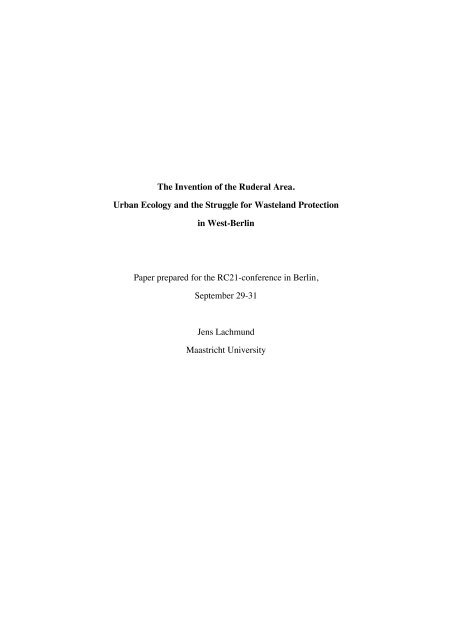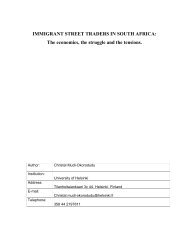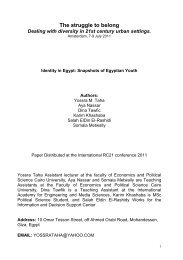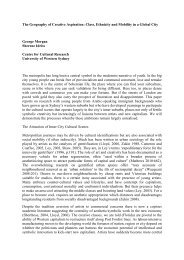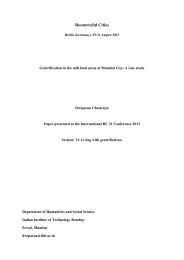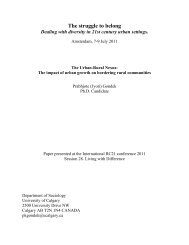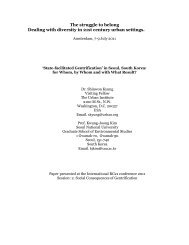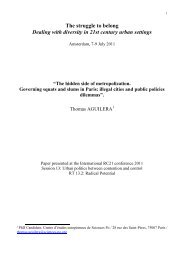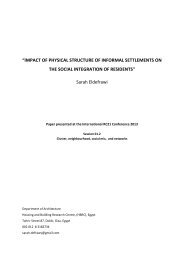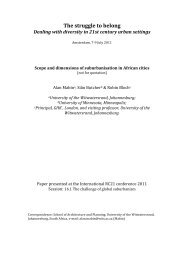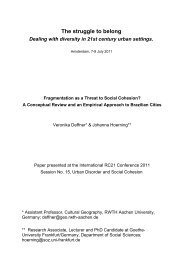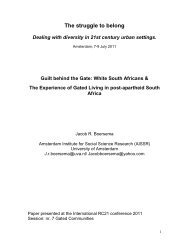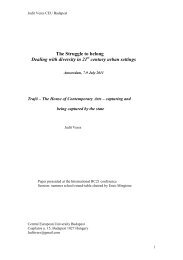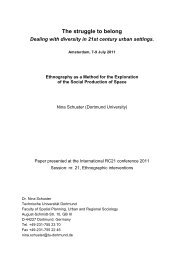The Invention of the Ruderal Area. Urban Ecology and the Struggle ...
The Invention of the Ruderal Area. Urban Ecology and the Struggle ...
The Invention of the Ruderal Area. Urban Ecology and the Struggle ...
You also want an ePaper? Increase the reach of your titles
YUMPU automatically turns print PDFs into web optimized ePapers that Google loves.
<strong>The</strong> <strong>Invention</strong> <strong>of</strong> <strong>the</strong> <strong>Ruderal</strong> <strong>Area</strong>.<br />
<strong>Urban</strong> <strong>Ecology</strong> <strong>and</strong> <strong>the</strong> <strong>Struggle</strong> for Wastel<strong>and</strong> Protection<br />
in West-Berlin<br />
Paper prepared for <strong>the</strong> RC21-conference in Berlin,<br />
September 29-31<br />
Jens Lachmund<br />
Maastricht University
Probably no o<strong>the</strong>r city <strong>of</strong> a comparable size has been as thoroughly scrutinized for its<br />
urban wildlife as <strong>the</strong> walled city <strong>of</strong> West-Berlin. Whereas field ecologists elsewhere<br />
focused mainly on communities <strong>and</strong> ecosystems that were located in <strong>the</strong> countryside,<br />
in allegedly natural l<strong>and</strong>scapes <strong>of</strong> o<strong>the</strong>r continents or in marine environments,<br />
ecologists in West-Berlin turned to <strong>the</strong>ir own city as <strong>the</strong>ir primary research object <strong>and</strong><br />
practical fieldwork site. From <strong>the</strong> 1960s onwards, <strong>the</strong> vegetation ecologist Herbert<br />
Sukopp, <strong>and</strong> a growing number <strong>of</strong> collaborators, made Berlin one <strong>of</strong> <strong>the</strong> emblematic<br />
cases <strong>of</strong> <strong>the</strong> newly emerging specialty <strong>of</strong> urban ecology. <strong>The</strong>y monitored <strong>the</strong><br />
development <strong>of</strong> <strong>the</strong> city’s flora <strong>and</strong> fauna <strong>and</strong> explored how <strong>the</strong> latter were effected<br />
by <strong>the</strong> specific conditions <strong>of</strong> <strong>the</strong> urban environment. Ra<strong>the</strong>r than being a purely<br />
academic endeavor, this urban ecology also had a clear political mission: ecology was<br />
supposed to monitor <strong>the</strong> detrimental effects <strong>of</strong> urbanization on urban wildlife, <strong>and</strong><br />
<strong>the</strong>reby, to create a base for a more rational planning <strong>of</strong> future cities.<br />
It was in particular with regard to urban wastel<strong>and</strong>s such as rubble areas <strong>and</strong><br />
ab<strong>and</strong>oned railway tracks that <strong>the</strong>se knowledges <strong>and</strong> policies took shape. From WWII<br />
onwards <strong>the</strong>se spaces had already been <strong>the</strong> primary fieldwork sites on which<br />
ecologists studied <strong>the</strong> development <strong>of</strong> urban flora <strong>and</strong> fauna. Drawing upon this<br />
fieldwork, ecologists <strong>and</strong> activist groups claimed that urban wastel<strong>and</strong>s were valuable<br />
“ruderal areas” or “biotopes” which displayed a high amount <strong>of</strong> species diversity, <strong>and</strong><br />
accordingly, called for preserving <strong>the</strong>m. In Berlin, eventually two <strong>of</strong> <strong>the</strong>se areas<br />
where turned into so-called nature parks.<br />
In this paper I want to use <strong>the</strong> example <strong>of</strong> urban wastel<strong>and</strong>s to shed light on<br />
<strong>the</strong> role <strong>of</strong> place in <strong>the</strong> production <strong>and</strong> institutionalization <strong>of</strong> scientific environmental<br />
<br />
1
knowledge. 1<br />
Scholarship <strong>of</strong> environmental history <strong>and</strong> sociology <strong>of</strong>ten tends to view<br />
science as an objective <strong>and</strong> more or less universal resource that allows actors to grasp<br />
<strong>the</strong> nature <strong>of</strong> environmental problems <strong>and</strong> to solve <strong>the</strong>m in a more rational way.<br />
Places in such analysis thus figure primarily as <strong>the</strong> passive object or target domain to<br />
which such knowledge is applied. Constructivist or cultural approaches in<br />
environmental studies have <strong>of</strong>ten criticized <strong>the</strong> realist assumptions <strong>of</strong> this view <strong>and</strong><br />
argued that environmental knowledge is <strong>the</strong> outcome <strong>of</strong> discourses, definitional<br />
processes or broader patters <strong>of</strong> cultural perception. Again, however, environmental<br />
spaces <strong>and</strong> places are merely seen as passive target objects to which such definitions<br />
are attributed. In this paper I want to demonstrate how our underst<strong>and</strong>ing <strong>of</strong> <strong>the</strong><br />
construction <strong>of</strong> environmental problems can benefit from a more thorough <strong>and</strong><br />
systematic analysis <strong>of</strong> <strong>the</strong> spatialities in which <strong>the</strong>se problems are embedded. To a<br />
large extent, I draw upon a notion <strong>of</strong> science as local practice as it has been developed<br />
in various str<strong>and</strong>s <strong>of</strong> recent history <strong>and</strong> sociology <strong>of</strong> science.<br />
Drawing upon <strong>the</strong>se considerations, I view urban wastel<strong>and</strong>s not just as<br />
preexisting objects, nor just as passive containers <strong>of</strong> ecological fieldwork practices.<br />
<strong>The</strong> wastel<strong>and</strong> was a locale which interacted in multiple <strong>and</strong> mutually constitutive<br />
ways with <strong>the</strong> epistemic <strong>and</strong> political practices that were situated within or around it.<br />
First, it acted as an intermediary space in which new forms <strong>of</strong> ecological expertise <strong>and</strong><br />
urban policy were co-produced (Jasan<strong>of</strong>f 2003). A clear-cut boundary between<br />
science <strong>and</strong> o<strong>the</strong>r forms <strong>of</strong> knowing <strong>and</strong> acting on behalf <strong>of</strong> <strong>the</strong> sites never existed<br />
1 This paper is adapted from several prior publications: Lachmund, J. (2013).<br />
Greening Berlin. <strong>The</strong> Co-production <strong>of</strong> Science, Politics, <strong>and</strong> <strong>Urban</strong> Nature.<br />
Boston/Mass., MIT Press. Lachmund, J. Knowing <strong>the</strong> <strong>Urban</strong> Wastel<strong>and</strong>. Earthly<br />
Politics. Local <strong>and</strong> Global in Environmental Governance. S. Jasan<strong>of</strong>f <strong>and</strong> M. Long<br />
Martello. Boston, Mass., MIT Press: 241-262, Lachmund, J. (2011). Greening <strong>the</strong><br />
City. <strong>Urban</strong> L<strong>and</strong>scapes in <strong>the</strong> Twenieth Century. D. Brantz <strong>and</strong> S. Dümpelmann.<br />
Charlottesville, Virginia University Press: 204-228. <br />
<br />
2
during this process. On <strong>the</strong> one h<strong>and</strong>, ecological knowledge formed part <strong>of</strong> <strong>the</strong> very<br />
definition <strong>of</strong> <strong>the</strong> site as a “ruderal area” <strong>and</strong> it materialized in new forms <strong>of</strong> ordering<br />
this space. On <strong>the</strong> o<strong>the</strong>r, it was also a local setting in which issues <strong>of</strong> urban politics<br />
<strong>and</strong> nature conservation were translated into research practices <strong>and</strong> in which new<br />
kinds <strong>of</strong> knowledge <strong>of</strong> <strong>the</strong> city’s flora <strong>and</strong> fauna were produced which, in turn,<br />
informed <strong>the</strong> discourses <strong>and</strong> practices <strong>of</strong> governing <strong>the</strong>se spaces.<br />
I will trace <strong>the</strong> local discursive <strong>and</strong> political trajectory <strong>of</strong> <strong>the</strong> “ruderal biotope”<br />
in West-Berlin through three phases: (1) <strong>the</strong> invention <strong>of</strong> <strong>the</strong> category in <strong>the</strong> fieldwork<br />
<strong>of</strong> ecologists as has developed from <strong>the</strong> 1950s; (2) <strong>the</strong> political campaigns <strong>of</strong><br />
ecologists <strong>and</strong> o<strong>the</strong>r urban actors for <strong>the</strong> protection <strong>of</strong> <strong>the</strong>se areas (since <strong>the</strong> late<br />
1970s); <strong>and</strong> (3) <strong>the</strong> negotiation <strong>of</strong> a new regime <strong>of</strong> order for <strong>the</strong>se places.<br />
Ecological fieldwork <strong>and</strong> <strong>the</strong> making <strong>of</strong> <strong>the</strong> ruderal area<br />
So-called “ruderal sites”, a term which is based on <strong>the</strong> Latin word for rubble (rudus),<br />
had been studied by botanists interested in <strong>the</strong> composition <strong>of</strong> local flora <strong>and</strong> <strong>the</strong><br />
invasion <strong>of</strong> “alien” plants since <strong>the</strong> 19th century. Typically, <strong>the</strong>y were found on<br />
farms, along streets, or railway tracks. What was new after 1945, however, was <strong>the</strong><br />
transformation <strong>of</strong> whole cityscapes into large fields <strong>of</strong> rubble. Issues such as <strong>the</strong><br />
spread <strong>of</strong> new plant species or <strong>of</strong> vegetation composition could thus be studied on a<br />
new scale <strong>and</strong> in an environment that differed considerably from previously known<br />
places. Whereas in o<strong>the</strong>r cities rubble areas were quickly redeveloped in <strong>the</strong> 1960s, it<br />
was <strong>the</strong> effect <strong>of</strong> <strong>the</strong> politically <strong>and</strong> economically marginal situation <strong>of</strong> West-Berlin<br />
that meant <strong>the</strong>y were developed here at a much slower pace. Notably, until <strong>the</strong> early<br />
1980s, <strong>the</strong> Nor<strong>the</strong>rn part <strong>of</strong> <strong>the</strong> Kreuzberg district <strong>and</strong> <strong>the</strong> adjacent former<br />
Diplomatenviertel remained as vast l<strong>and</strong>scapes <strong>of</strong> rubble. Moreover, in ab<strong>and</strong>oned<br />
<br />
3
ailway areas fur<strong>the</strong>r wastel<strong>and</strong>s existed that attracted ecologists’ interest in <strong>the</strong> late<br />
1970s.<br />
At least partly, <strong>the</strong> turn <strong>of</strong> West-Berlin’s ecology to <strong>the</strong> city can be<br />
explained by <strong>the</strong> geopolitical situation. Due to <strong>the</strong> deprivation from its hinterl<strong>and</strong>,<br />
many field ecologists tended to concentrate on <strong>the</strong>ir own city when doing practical<br />
fieldwork. A central role was <strong>the</strong>reby played by Sukopp who, in 1969, became a<br />
pr<strong>of</strong>essor at <strong>the</strong> Technical University where he subsequently established (toge<strong>the</strong>r<br />
with two o<strong>the</strong>r pr<strong>of</strong>essors) a distinct department for ecology in 1972/73. Beginning<br />
with his 1958 dissertation <strong>the</strong>sis (a study <strong>of</strong> <strong>the</strong> fens within <strong>the</strong> Berlin Grunewald),<br />
Sukopp’s research had been nearly exclusively devoted to West-Berlin. His positions<br />
as a pr<strong>of</strong>essor <strong>and</strong> not only enabled him to continue his research on <strong>the</strong> Berlin flora<br />
<strong>and</strong> to formulate a more systematic approach to <strong>the</strong> study <strong>of</strong> urban nature but also to<br />
act as a political entrepreneur; creating networks between scientists, organizing<br />
material <strong>and</strong> institutional resources <strong>and</strong> making claims on policy <strong>and</strong> planning issues.<br />
Within a few years Sukopp, along with a growing number <strong>of</strong> students <strong>and</strong> assistant<br />
pr<strong>of</strong>essors who worked with him, had become <strong>the</strong> most renowned representatives <strong>of</strong><br />
German urban ecology.<br />
It was <strong>the</strong> goal <strong>of</strong> <strong>the</strong>se studies to characterize <strong>the</strong> vegetation <strong>and</strong> to make<br />
sense <strong>of</strong> <strong>the</strong> direction in which it would fur<strong>the</strong>r develop, i.e. so-called succession.<br />
Ecologists considered <strong>the</strong> vegetation <strong>of</strong> <strong>the</strong>se sites as a special type, <strong>the</strong> ‘ruderal<br />
vegetation’ <strong>and</strong> <strong>the</strong> wastel<strong>and</strong>s <strong>the</strong>mselves were later called ‘ruderal areas’ or ‘ruderal<br />
biotopes’. As Scholz (Scholz 1956) had stated in his <strong>the</strong>sis in 1956, it was<br />
characterized by <strong>the</strong> abundance <strong>of</strong> neophytes, <strong>of</strong>ten <strong>of</strong> Sou<strong>the</strong>rn origin, that benefited<br />
from <strong>the</strong> environmental conditions <strong>of</strong> <strong>the</strong> city, especially <strong>the</strong> warmer climate. In <strong>the</strong><br />
<br />
4
following years, Sukopp <strong>and</strong> his co-workers developed a detailed scheme <strong>of</strong> <strong>the</strong> series<br />
<strong>of</strong> plant communities through which <strong>the</strong> succession developed at <strong>the</strong>se rubble sites<br />
(Sukopp 1971).<br />
Studying wastel<strong>and</strong>s involved, at least temporarily, <strong>the</strong> social <strong>and</strong> material<br />
appropriation <strong>of</strong> <strong>the</strong>se spaces as sites <strong>of</strong> knowledge production. Ecologist visited <strong>the</strong><br />
sites, assembled data, usually by taking notes on paper or in a field notebook.<br />
Ga<strong>the</strong>ring data also involved picking out herbaria specimen or hunting animal. More<br />
systematic surveys <strong>of</strong> <strong>the</strong> vegetation were done on sample sites that were delineated<br />
on <strong>the</strong> ground. From time to time, ecologists also drew maps <strong>of</strong> <strong>the</strong> site’s vegetation<br />
structure or <strong>of</strong> <strong>the</strong> distribution <strong>of</strong> animal species. <strong>The</strong>se practices <strong>of</strong> site visiting<br />
configured <strong>the</strong> wastel<strong>and</strong> as an observational space, highlighting certain epistemically<br />
relevant features at <strong>the</strong> expense <strong>of</strong> o<strong>the</strong>rs. <strong>The</strong> visits were carefully scheduled<br />
according to <strong>the</strong> seasonal or <strong>the</strong> daily life cycles <strong>of</strong> plants <strong>and</strong> animals. <strong>The</strong> paths <strong>of</strong><br />
<strong>the</strong> visitors around <strong>the</strong> site connected certain points <strong>of</strong> interest. Observation work on<br />
<strong>the</strong> area also included small modifications <strong>of</strong> its material l<strong>and</strong>scape, such as placing<br />
traps for catching insects or delineating sample sites for vegetation surveys with<br />
plugs.<br />
Through <strong>the</strong> practice <strong>of</strong> site visiting, wastel<strong>and</strong>s became a node within <strong>the</strong><br />
network <strong>of</strong> routine paths <strong>of</strong> local botanists (amateurs <strong>and</strong> scientists alike) creating<br />
meanings <strong>of</strong> place as well as subjectivities that thrive on <strong>the</strong>se meanings. Individual<br />
ecologists developed an almost intimate relationship with <strong>the</strong> place, both in terms <strong>of</strong><br />
<strong>the</strong>ir detailed knowledge as well as emotional commitment. <strong>The</strong> practice <strong>of</strong> visiting<br />
created a local community <strong>of</strong> people in which data was exchanged <strong>and</strong> a common<br />
experience <strong>and</strong> commitment was shared. <strong>The</strong> sites also brought toge<strong>the</strong>r people from<br />
different specialties such as botanists, vegetation scientist or experts <strong>of</strong> certain groups<br />
<br />
5
<strong>of</strong> animals. <strong>The</strong>re also existed collective forms <strong>of</strong> site visits, ei<strong>the</strong>r by two or three<br />
people or in <strong>the</strong> form <strong>of</strong> organized excursions. <strong>The</strong>se excursions allowed <strong>the</strong><br />
participants to exchange observatory skills <strong>and</strong> knowledge <strong>and</strong> to cooperatively<br />
elaborate <strong>the</strong>ir practices <strong>of</strong> observation <strong>and</strong> related taxonomies <strong>of</strong> species, vegetation,<br />
<strong>and</strong> ecosystem-types.<br />
What kind <strong>of</strong> space was performed in <strong>the</strong> context <strong>of</strong> <strong>the</strong>se practices <strong>and</strong> <strong>the</strong><br />
circuits <strong>of</strong> observation that <strong>the</strong>y sustained Most people tended to see wastel<strong>and</strong>s as<br />
eyesores. Although located in <strong>the</strong> city, <strong>the</strong>y were “spaces at <strong>the</strong> margin” (Shields<br />
1991), which were used for shadow activities that o<strong>the</strong>rwise did not find a place in <strong>the</strong><br />
city. With <strong>the</strong>ir surveys, however, ecologists reframed <strong>the</strong>se sites as a new spatial<br />
entity, as ruderal areas or ruderal vegetation. Among <strong>the</strong>ir features was a high<br />
species diversity as well as <strong>the</strong> occurrence <strong>of</strong> specific forms <strong>of</strong> flora <strong>and</strong> vegetation.<br />
Ecologists cited characteristics <strong>of</strong> <strong>the</strong> soil <strong>and</strong> <strong>the</strong> climate <strong>of</strong> <strong>the</strong> city to explain <strong>the</strong><br />
specific composition <strong>of</strong> plants. Moreover, increasing railway traffic was mentioned as<br />
a reason for <strong>the</strong> spread <strong>of</strong> foreign seeds to Berlin. For ecologists, wastel<strong>and</strong>s were <strong>the</strong><br />
prototype <strong>of</strong> an urban ecosystem: <strong>the</strong>ir marginality within <strong>the</strong> urban environment<br />
allowed nature to thrive almost unimpeded at <strong>the</strong>se sites; <strong>and</strong> yet <strong>the</strong>y were<br />
determined by <strong>the</strong> specific environmental conditions <strong>of</strong> <strong>the</strong> city (Kowarik 1991).<br />
Wastel<strong>and</strong> conservation: <strong>The</strong> politics <strong>of</strong> an ecological category<br />
Ecologists did not only appropriate wastel<strong>and</strong>s as sites <strong>of</strong> knowledge production.<br />
From <strong>the</strong> 1980s onwards, <strong>the</strong>y also called for <strong>the</strong> protection <strong>of</strong> ruderal areas as urban<br />
nature parks. <strong>The</strong>se calls for wastel<strong>and</strong> preservation found much resonance in citizen<br />
activist groups who opposed civil construction projects that were planned on <strong>the</strong>se<br />
<br />
6
sites. Bürgerinitiativen (literally citizens’ initiatives) launched campaigns, lobbied<br />
local politicians <strong>and</strong> initiated lawsuits against public authorities. <strong>The</strong> protest for<br />
wastel<strong>and</strong> preservation included fanciful forms <strong>of</strong> action. For example, activists <strong>of</strong> <strong>the</strong><br />
Bürgerinitiative Südgelände dressed-up as plants <strong>and</strong> animals when <strong>the</strong>y invaded <strong>the</strong><br />
<strong>of</strong>fice <strong>of</strong> <strong>the</strong> Berlin civil construction administration to voice <strong>the</strong>ir concern about <strong>the</strong><br />
wildlife that would be lost if <strong>the</strong> city’s plan for a new freight station at that site was<br />
realized. In 1988, left-wing activists even squatted a small wastel<strong>and</strong> next to <strong>the</strong> wall<br />
that was just traded in by West-Berlin from <strong>the</strong> GDR. <strong>The</strong> activists established a camp<br />
on <strong>the</strong> site in order to protest against <strong>the</strong> West-Berlin government, which was about to<br />
sacrifice this allegedly valuable ruderal biotope for <strong>the</strong> construction <strong>of</strong> a new<br />
highway. <strong>The</strong> call for wastel<strong>and</strong> preservation also found supporters within <strong>the</strong> Berlin<br />
parliament. Notably, <strong>the</strong> faction <strong>of</strong> <strong>the</strong> Alternative Liste submitted various requests to<br />
protect <strong>the</strong> wastel<strong>and</strong>s <strong>of</strong> West-Berlin’s ‘central area’.<br />
As a result <strong>of</strong> both ecologists’ lobbying as well as mounting public protest, a<br />
number <strong>of</strong> Berlin’s ruderal areas were actually turned into protected areas. In 1982,<br />
after a small grove <strong>of</strong> Black Locust had developed in a bombed plot in <strong>the</strong> district <strong>of</strong><br />
Kreuzberg, <strong>the</strong> area was designated as a “ruderal vegetation park” (Schaumann 1984).<br />
Although ecologists could not prevent <strong>the</strong> construction <strong>of</strong> a new museum for<br />
technology at <strong>the</strong> fringe <strong>of</strong> <strong>the</strong> so-called Gleisdreieck (an ab<strong>and</strong>oned railway area), a<br />
considerable part <strong>of</strong> <strong>the</strong> adjacent vegetation was turned into a Naturdenkmal (nature<br />
monument). One <strong>of</strong> <strong>the</strong> most successful projects <strong>of</strong> wastel<strong>and</strong> preservation, a nature<br />
park at <strong>the</strong> Südgelände (ano<strong>the</strong>r ab<strong>and</strong>oned railway area), was only finished in 2001.<br />
After <strong>the</strong> unification <strong>of</strong> <strong>the</strong> city, Berlin ecologists <strong>and</strong> activists extended <strong>the</strong>ir claims<br />
on <strong>the</strong> various wastel<strong>and</strong>s that existed in <strong>the</strong> former East <strong>of</strong> <strong>the</strong> city. In one case, a<br />
<br />
7
former airport in Berlin-Adlersh<strong>of</strong> (Flugplatz Johannisthal) also led to <strong>the</strong><br />
designation <strong>of</strong> a large ruderal area as a l<strong>and</strong>scape park.<br />
Not always, however, were ecologists that successful. All too <strong>of</strong>ten, calls for<br />
wastel<strong>and</strong>s preservation clashed with powerful l<strong>and</strong>-use interests <strong>and</strong> could <strong>the</strong>refore<br />
not or only partly be realized. This became clear in 1986, when a hotel was built at <strong>the</strong><br />
so-called Dörnbergdreieck, a rubble area in <strong>the</strong> district <strong>of</strong> Tiergarten – a place that<br />
ecologists considered as one <strong>of</strong> <strong>the</strong>ir most important fieldwork sites. Even <strong>the</strong> joined<br />
opposition <strong>of</strong> academic ecologists, nature conservation <strong>of</strong>ficials <strong>and</strong> neighborhood<br />
activists could not keep <strong>the</strong> Senate from admitting <strong>the</strong> investor’s plan to build <strong>the</strong><br />
hotel. Some <strong>of</strong> <strong>the</strong>se conflicts lingered until way beyond <strong>the</strong> fall <strong>of</strong> <strong>the</strong> wall, <strong>and</strong> were<br />
only settled within <strong>the</strong> recent decade. <strong>The</strong> unification <strong>and</strong> <strong>the</strong> subsequent rebuilding <strong>of</strong><br />
<strong>the</strong> capital made <strong>the</strong> claims for ambitious wastel<strong>and</strong> protection schemes even less<br />
realistic. Many wastel<strong>and</strong>s <strong>of</strong> former West-Berlin, as well as those that ecologists<br />
hoped to protect in <strong>the</strong> East, were eventually developed. In this sense, <strong>the</strong> Südgelände<br />
<strong>and</strong> <strong>the</strong> Johannisthal airports remained as <strong>the</strong> two outst<strong>and</strong>ing exemptions. Among <strong>the</strong><br />
‘lost’ wastel<strong>and</strong>s was even <strong>the</strong> large area around <strong>the</strong> Gleisdreieck that, in <strong>the</strong> 1980s,<br />
had attracted attention <strong>of</strong> ecologists <strong>and</strong> l<strong>and</strong>scape planners even from outside <strong>of</strong><br />
Germany. In <strong>the</strong> early 1990s, large parts <strong>of</strong> <strong>the</strong> area were used as a logistics center for<br />
<strong>the</strong> construction work at <strong>the</strong> adjacent Potsdamer Platz. After an intricate debate about<br />
financial compensation which was supossed to be provided by <strong>the</strong> developers <strong>of</strong> <strong>the</strong><br />
Potsdamer Platz, a considerable part <strong>of</strong> <strong>the</strong> area was turned into an aes<strong>the</strong>tically<br />
shaped urban park. With <strong>the</strong> exemption <strong>of</strong> a small <strong>and</strong> protected Black Locust grove,<br />
however, <strong>the</strong> vast spontaneous vegetation that once covered this site has now<br />
disappeared.<br />
<br />
8
From protection to design<br />
<strong>The</strong> more <strong>the</strong> wastel<strong>and</strong> came to be framed as a “ruderal area” <strong>and</strong> urban planning<br />
decisions considered its value as “nature”, <strong>the</strong> social use <strong>and</strong> material form <strong>of</strong> <strong>the</strong>se<br />
areas emerged as new issues <strong>of</strong> public contestation. Instead <strong>of</strong> being just left on its<br />
own, <strong>the</strong> wastel<strong>and</strong> became itself reconstituted as <strong>the</strong> target <strong>of</strong> competing modes <strong>of</strong><br />
socio-material ordering. I will focus on <strong>the</strong> Südgelände to briefly sketch two main<br />
issues that figured in this context.<br />
<strong>The</strong> first <strong>the</strong>me concerned <strong>the</strong> extent to which <strong>the</strong> area should primarily be<br />
organized as a reserve for <strong>the</strong> protection <strong>of</strong> plant <strong>and</strong> animals species, or alternatively<br />
should be shaped as a more formal park. <strong>The</strong> notion <strong>of</strong> a nature park can be seen as a<br />
compromise between <strong>the</strong>se two concepts. Initially, <strong>the</strong> plasticity <strong>and</strong><br />
comprehensiveness <strong>of</strong> this concept served to create alliances between groups <strong>of</strong> actors<br />
who tended to prioritize ei<strong>the</strong>r <strong>of</strong> <strong>the</strong>se two aspects. However, during <strong>the</strong> process <strong>of</strong><br />
planning <strong>and</strong> designing <strong>the</strong> park, <strong>the</strong> tensions inherent in this concept became evident.<br />
From 1991 onwards, <strong>the</strong> design process was organized by Grün Berlin - a<br />
quango responsible for green planning in Berlin. Design plans were elaborated by two<br />
l<strong>and</strong>scape planning <strong>of</strong>fices which maintained close relationships, both personally as<br />
well as intellectually, to scientific urban ecology (ÖkoCon 1991)Grün Berlin, 1995).<br />
<strong>The</strong>y called for a relatively restrictive policy with respect to public access, <strong>and</strong> had<br />
strong reservations against any artful design. However, when <strong>the</strong> l<strong>and</strong>scape planners<br />
<br />
9
presented <strong>the</strong>ir conception, it met harsh resistance from Grün Berlin as well as from<br />
<strong>the</strong> local activist group at <strong>the</strong> Südgelände. <strong>The</strong> Allianz Umweltstiftung, which<br />
provided financial support for <strong>the</strong> project, also became a strong opponent <strong>of</strong> such<br />
restrictions. <strong>The</strong>se issues were debated by a consulting panel in which <strong>the</strong> different<br />
groups were represented. Although <strong>the</strong> participants agreed that <strong>the</strong> existing features <strong>of</strong><br />
flora <strong>and</strong> fauna should be protected <strong>and</strong> be made <strong>the</strong> major <strong>the</strong>me <strong>of</strong> <strong>the</strong> park, design<br />
plans showed a constant move from a relatively rigid conservation scheme toward a<br />
park that was more accessible to <strong>the</strong> public <strong>and</strong>, at least partly, artistically designed.<br />
According to <strong>the</strong> original plan, <strong>the</strong> meadows in <strong>the</strong> center <strong>of</strong> <strong>the</strong> area were to<br />
be turned into a nature reserve <strong>and</strong> fenced <strong>of</strong>f to <strong>the</strong> public. Only a small viewing<br />
platform at <strong>the</strong> fringe <strong>of</strong> <strong>the</strong> site would have allowed visitors to visually access <strong>the</strong><br />
area. A revised plan, which was presented in 1995, included a wooden foot-bridge for<br />
visitors (Grün Berlin 1995). <strong>The</strong> trail that was eventually constructed, moved <strong>the</strong><br />
project a considerable step fur<strong>the</strong>r toward l<strong>and</strong>scape art. A group <strong>of</strong> metal sculpture<br />
artists, who had <strong>the</strong>ir workshop in an old railway shed on <strong>the</strong> fringe <strong>of</strong> <strong>the</strong><br />
Südgelände, proposed an alternative design for <strong>the</strong> pathway. This “walk-able<br />
sculpture” (begehbare Skulptur) was made <strong>of</strong> rusty steel <strong>and</strong> consisted <strong>of</strong> a narrow<br />
path that rested on low metal rolls. At some point, fur<strong>the</strong>r sculptures (also made out <strong>of</strong><br />
rusty steel) were added along <strong>the</strong> track. <strong>The</strong> rusty material <strong>and</strong> <strong>the</strong> wheel-like shape <strong>of</strong><br />
<strong>the</strong> rolls were an explicit allusion to <strong>the</strong> history <strong>of</strong> <strong>the</strong> site as a railway station. <strong>The</strong><br />
track allowed people to walk into <strong>the</strong> center <strong>of</strong> <strong>the</strong> nature reserve without having any<br />
physical contact with <strong>the</strong> soil <strong>and</strong> vegetation even though <strong>the</strong>y worked close to <strong>the</strong><br />
ground <strong>and</strong> were not restricted by a railing. More than being just a pathway system,<br />
this sculpture turned <strong>the</strong> Südgelände into an artsy place. Nature <strong>and</strong> art became<br />
closely connected to each o<strong>the</strong>r, one providing <strong>the</strong> background for <strong>the</strong> o<strong>the</strong>r.<br />
<br />
10
As <strong>the</strong>se debates show, ecological framings <strong>of</strong> <strong>the</strong> site <strong>and</strong> <strong>the</strong> attempt to<br />
aes<strong>the</strong>tically design a park existed in a relatively uneasy relationship with each o<strong>the</strong>r.<br />
However, aes<strong>the</strong>tic design was not intrinsically at odds with ecology. Negotiation<br />
between ecologists <strong>and</strong> conservationists, on <strong>the</strong> one h<strong>and</strong>, <strong>and</strong> designers, on <strong>the</strong> o<strong>the</strong>r,<br />
resulted in mutual alignments between <strong>the</strong>se perspectives that most <strong>of</strong> <strong>the</strong> participants<br />
were willing to accept.<br />
A second issue <strong>of</strong> order emerged when l<strong>and</strong>scape planning consultants<br />
proposed an ecological management scheme for <strong>the</strong> site. In <strong>the</strong> early 1990s, a survey<br />
established that <strong>the</strong> woody vegetation had increased dramatically. Accordingly, it<br />
would not have taken much time until a wood would have covered <strong>the</strong> entire area.<br />
Ecologists maintained that this would have seriously diminished <strong>the</strong> quality <strong>of</strong> <strong>the</strong> site<br />
because many <strong>of</strong> <strong>the</strong> rare species depended upon <strong>the</strong> existence <strong>of</strong> meadows.<br />
Accordingly, action was to be taken in order to avoid <strong>the</strong> fur<strong>the</strong>r development <strong>of</strong> <strong>the</strong><br />
woodl<strong>and</strong>s. In order to prevent <strong>the</strong> expansion <strong>of</strong> <strong>the</strong> woodl<strong>and</strong>, various trees that had<br />
spread in <strong>the</strong> meadows were cut. Park management also included <strong>the</strong> mowing <strong>of</strong><br />
smaller plots, in order to preserve <strong>the</strong>m in <strong>the</strong> state <strong>of</strong> early succession. Fur<strong>the</strong>rmore,<br />
single plants were removed when <strong>the</strong>y tended to abound in <strong>the</strong> meadows <strong>and</strong> were<br />
supposed to make <strong>the</strong>m more homogenous.<br />
For ecologists, management was an ambivalent issue. On <strong>the</strong> one h<strong>and</strong>, <strong>the</strong>y<br />
were expert advisors for park management <strong>and</strong>, in this position embraced <strong>the</strong> turn to<br />
management. What, in <strong>the</strong> first instance, had made <strong>the</strong> site so interesting for<br />
ecologists however, was just that it allowed <strong>the</strong> tracing <strong>of</strong> <strong>the</strong> spontaneous<br />
development <strong>of</strong> flora <strong>and</strong> fauna in <strong>the</strong> urban environment over time. In that respect,<br />
ecologists had an interest in keeping <strong>the</strong> sites free from any management intervention.<br />
This conflict was settled by <strong>the</strong> division <strong>of</strong> <strong>the</strong> park into different areas: areas in <strong>the</strong><br />
<br />
11
wood <strong>of</strong> robinia in which succession is still allowed to proceed spontaneously, <strong>and</strong> <strong>the</strong><br />
open meadows, in which a quite rigid conservation scheme applies.<br />
Some conservation activists <strong>and</strong> administration <strong>of</strong>ficials deemed <strong>the</strong> very idea<br />
<strong>of</strong> management as an illegitimate intervention in what <strong>the</strong>y saw as a natural process.<br />
Gardeners who cut trees or mowed meadows in a nature reserve also aroused <strong>the</strong><br />
suspicion <strong>of</strong> park visitors. <strong>The</strong> definition <strong>of</strong> maintenance schemes was fur<strong>the</strong>r<br />
complicated by <strong>the</strong> diversity <strong>of</strong> goals that coexisted within <strong>the</strong> management agenda.<br />
What was deemed to be an intervention on behalf <strong>of</strong> plants <strong>and</strong> vegetation types <strong>of</strong>ten<br />
was criticized for its detrimental effects to o<strong>the</strong>r plants or to <strong>the</strong> fauna.<br />
Conclusion<br />
<strong>The</strong> story <strong>of</strong> West-Berlin’s wastel<strong>and</strong>s is a good example for <strong>the</strong> place-based nature <strong>of</strong><br />
a field science (Henke 2000, Kohler 2002, Gieryn 2006). I have tried to shed light on<br />
<strong>the</strong> continuous enactment <strong>of</strong> <strong>the</strong> place in <strong>the</strong> temporal unfolding <strong>of</strong> fieldwork. In all<br />
three phases, fieldwork proceeded by means <strong>of</strong> a mutually constitutive interaction<br />
between scientists’ activities <strong>and</strong> <strong>the</strong> social <strong>and</strong> material features <strong>of</strong> <strong>the</strong> site.<br />
Ecologists <strong>and</strong> <strong>the</strong> amateur naturalist who cooperated with <strong>the</strong>m were urban space<br />
pioneers, who appropriated marginal spaces <strong>and</strong> constructed a new framing <strong>of</strong> <strong>the</strong>ir<br />
biophysical qualities <strong>and</strong> <strong>the</strong>ir functioning in <strong>the</strong> urban context. <strong>The</strong> campaign for<br />
preserving wastel<strong>and</strong>s translated ecologists’ categories <strong>and</strong> commitments into a<br />
broader public concern. Finally, <strong>the</strong> quest for design <strong>and</strong> management led to a<br />
recursive adaptation <strong>of</strong> <strong>the</strong> material design <strong>of</strong> <strong>the</strong> space to <strong>the</strong> contested precepts that<br />
guided its preservation. It was in <strong>the</strong> course <strong>of</strong> <strong>the</strong> continuous articulation <strong>of</strong> <strong>the</strong>se<br />
diverse practices <strong>and</strong> discourses that <strong>the</strong> ruderal area as a new urban-spatial category<br />
was created, institutionalized <strong>and</strong> transformed.<br />
<br />
12
References<br />
Gieryn, T. F. (2006). "City as Truth-‐Spot: Laboratories <strong>and</strong> Field-‐Sites in <strong>Urban</strong> <br />
Studies." Social Studies <strong>of</strong> Science 36(1): 5-‐38. <br />
Grün Berlin (1995). Natur-‐Park Südgelände. Berlin. <br />
Henke, C. R. (2000). "Making a Place for Science: <strong>The</strong> Field Trial." Social Studies <br />
<strong>of</strong> Science 30(4): 483-‐511. <br />
Jasan<strong>of</strong>f, S., Ed. (2003). States <strong>of</strong> Knowledge. <strong>The</strong> co-‐production <strong>of</strong> science <strong>and</strong> <br />
social order. London, Routledge. <br />
Kohler, R. E. (2002). L<strong>and</strong>scapes <strong>and</strong> Labscapes. Exploring <strong>the</strong> Lab-‐Field Border <br />
in Biology. Chicago, University <strong>of</strong> Chicago Press. <br />
Kowarik, I. (1991). Unkraut oder Urwald Natur der vierten Art auf dem <br />
Gleisdreick. Gleisdreick morgen. Sechs Ideen für einen Park. B. B. GmbH <strong>and</strong> B. <br />
Kreuzberg. Berlin: 45-‐56. <br />
Lachmund, J. Knowing <strong>the</strong> <strong>Urban</strong> Wastel<strong>and</strong>. Earthly Politics. Local <strong>and</strong> Global in <br />
Environmental Governance. S. Jasan<strong>of</strong>f <strong>and</strong> M. Long Martello. Boston, Mass., MIT <br />
Press: 241-‐262. <br />
Lachmund, J. (2011). Greening <strong>the</strong> City. <strong>Urban</strong> L<strong>and</strong>scapes in <strong>the</strong> Twenieth <br />
Century. D. Brantz <strong>and</strong> S. Dümpelmann. Charlottesville, Virginia University Press: <br />
204-‐228. <br />
Lachmund, J. (2013). Greening Berlin. <strong>The</strong> Co-‐production <strong>of</strong> Science, Politics, <strong>and</strong> <br />
<strong>Urban</strong> Nature. Boston/Mass., MIT Press. <br />
ÖkoCon (1991). Ökologisch-‐L<strong>and</strong>schaftsplanerisches Gutachten Natur-‐Park <br />
Südgelände, 1. Zwischenbericht. <br />
Schaumann, M. (1984). "Erschließung eines <strong>Ruderal</strong>biotops in Berlin-‐<br />
Kreuzberg." Das Gartenamt 33: 160-‐161. <br />
Scholz, H. (1956). Die <strong>Ruderal</strong>vegetation Berlins. Berlin, Diss. FU-‐Berlin. <br />
Shields, R. (1991). Places on <strong>the</strong> Margin. Alternative geographies <strong>of</strong> modernity. <br />
London, Routledge. <br />
Sukopp, H. (1971). "Beiträge zur Ökologie von Chenopodium botrys L.. I. <br />
Verbreitung und Vergesellschaftung." Verh<strong>and</strong>lungen des Botanischen Vereins <br />
der Provinz Br<strong>and</strong>enburg 108: 3-‐74. <br />
<br />
13


